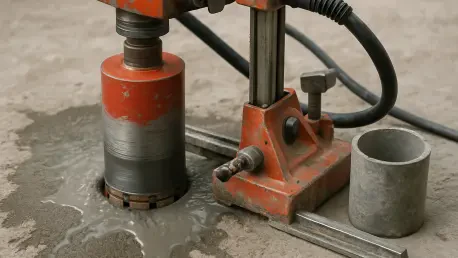The diamond core drilling market is on a remarkable trajectory, with projections estimating its value to soar to an impressive $2.5 billion by 2035, driven by a consistent compound annual growth rate (CAGR) of 5.2%. This growth underscores the critical importance of diamond-impregnated drill bits in delivering precision and durability for demanding tasks across industries like mining, construction, and environmental exploration. As the global appetite for infrastructure development and resource extraction intensifies, this market is poised to become a linchpin of industrial advancement over the coming decade. From urban skyscrapers to remote mining sites, the technology behind diamond core drilling supports projects that shape modern economies. The construction sector dominates with a 60% market share, while mining holds a substantial 40%, reflecting the dual pillars propelling demand. This surge signals not just economic opportunity but also a shift toward innovative, efficient, and sustainable drilling solutions on a global scale.
Forces Fueling Market Expansion
The rapid pace of urbanization and sprawling infrastructure projects across the globe stand as a primary catalyst for the diamond core drilling market’s robust growth. Nations are investing heavily in highways, tunnels, bridges, and urban complexes, all of which require precise drilling tools to ensure structural integrity and project success. This demand is especially pronounced in regions experiencing fast-paced development, where the technology is indispensable for laying the foundations of modern societies. Beyond mere construction, the ability of diamond core drilling to handle challenging terrains and materials makes it a go-to solution for ambitious projects. As governments and private entities push for accelerated development timelines through 2035, the reliance on such precision equipment is expected to intensify, cementing its role as a cornerstone of global progress and shaping the built environment in transformative ways.
Another significant driver stems from the mining industry’s unrelenting quest for valuable resources buried deep within the earth. With escalating demand for rare earth elements, precious metals, and other critical minerals, companies are compelled to explore harder-to-access deposits, often at greater depths or in tougher conditions. Diamond core drilling offers the durability and accuracy needed to tackle these challenges, enabling efficient extraction while minimizing operational setbacks. This technology’s adaptability to diverse geological settings further enhances its appeal, ensuring that mining operations can keep pace with global resource needs. As sustainability concerns also begin to influence mining practices, the market for advanced drilling solutions that balance productivity with environmental care continues to expand, positioning diamond core drilling as an essential tool for the industry’s evolving landscape.
Innovations Redefining Drilling Efficiency
Technological breakthroughs are revolutionizing the diamond core drilling market, with automation and digital integration emerging as game-changers for operational efficiency. AI-driven systems and remote-controlled rigs are reducing human error and enhancing safety by allowing operators to manage complex tasks from a distance. Real-time monitoring tools provide immediate data on drilling performance, enabling adjustments on the fly to optimize outcomes in dynamic environments. These advancements are particularly crucial in high-stakes projects where precision can make or break success. As companies race to adopt these cutting-edge solutions, the market is witnessing a shift toward smarter, more responsive equipment that not only boosts productivity but also sets new benchmarks for what’s possible in drilling technology over the next decade.
Equally impactful are the strides in hybrid drilling systems and eco-conscious equipment designs, which address both operational and environmental challenges. Manufacturers are developing durable drill bits and versatile rigs capable of handling a spectrum of applications, from surface drilling to underwater operations, with minimal downtime. The emphasis on energy-efficient and low-impact designs reflects a broader industry trend toward reducing ecological footprints while maintaining high performance. This balance is vital as regulatory pressures mount, pushing firms to innovate without sacrificing quality. Investments in multi-purpose machinery are also on the rise, allowing businesses to streamline costs and adapt to varied project demands. Such innovations signal a future where diamond core drilling not only meets industrial needs but also aligns with global priorities for sustainable progress.
Sustainability and Global Market Dynamics
Sustainability has evolved from a peripheral concern to a core imperative within the diamond core drilling market, reshaping how companies design and deploy their technologies. Stricter environmental regulations worldwide are prompting manufacturers to prioritize low-emission rigs and waste-minimizing processes, ensuring compliance while maintaining market relevance. Beyond traditional uses in construction and mining, applications in environmental surveys and water well drilling are gaining momentum, highlighting the industry’s pivot toward socially responsible practices. This shift is not merely reactive but strategic, as firms recognize that aligning with green standards can enhance brand reputation and open new revenue streams. As this trend strengthens through 2035, the market is likely to see sustainability become a defining factor in competitive differentiation and long-term growth.
Regional variations add another layer of complexity and opportunity to the market’s trajectory, with distinct dynamics shaping growth across different areas. North America and Europe remain frontrunners, leveraging advanced technologies and focusing on modernizing aging infrastructure with state-of-the-art drilling solutions. Meanwhile, the Asia-Pacific region is poised for the most rapid expansion, fueled by large-scale infrastructure initiatives in countries like China and India, alongside significant mining activities. Emerging markets in Latin America and Africa also present untapped potential, with their abundant natural resources attracting investment in exploration and extraction. These regions often require cost-effective, adaptable equipment to navigate infrastructural and logistical challenges, creating a diverse global landscape. This interplay between established and emerging markets underscores a vibrant, multifaceted industry where innovation and demand are continuously reshaping the competitive arena.
Path Forward for Industry Stakeholders
Reflecting on the journey, the diamond core drilling market has demonstrated resilience and adaptability, fueled by relentless innovation and a keen response to global industrial needs. Technological advancements like automation and hybrid systems have redefined operational standards, while the push for sustainability has reshaped equipment design and application scope. Regional growth patterns reveal a world of contrasts, with established markets driving tech adoption and emerging economies amplifying demand through resource and infrastructure pursuits. The steady climb to a projected $2.5 billion valuation by 2035 highlights the sector’s pivotal role in shaping modern progress across construction and mining landscapes.
Looking ahead, stakeholders must focus on strategic priorities to sustain this momentum. Embracing automation and digital tools will be critical to maintaining efficiency and safety in increasingly complex projects. Expanding into high-growth regions, particularly in Asia-Pacific and beyond, offers a chance to tap into burgeoning demand. Moreover, doubling down on sustainable practices and after-sales services can strengthen customer trust and ensure long-term relevance. By aligning innovation with environmental and regional needs, the industry can continue to carve a path of transformative impact, addressing future challenges with precision and responsibility.









